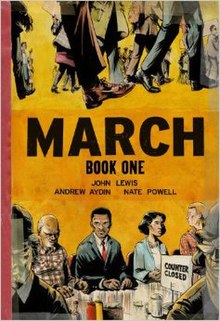March (comics)
| March: Book One | |
|---|---|

Cover to March: Book One. Art by Nate Powell
|
|
| Creator |
John Lewis Andrew Aydin Nate Powell |
| Page count | 128 pages |
| Publisher | Top Shelf Productions |
| Original publication | |
| Date of publication | August 13, 2013 |
| ISBN | |
| March: Book Two | |
|---|---|
| Creator |
John Lewis Andrew Aydin Nate Powell |
| Page count | 192 pages |
| Publisher | Top Shelf Productions |
| Original publication | |
| Date of publication | January 20, 2015 |
| ISBN | |
| March: Book Three | |
|---|---|
| Creator |
John Lewis Andrew Aydin Nate Powell |
| Page count | 256 pages |
| Publisher | Top Shelf Productions |
| Original publication | |
| Date of publication | August 2, 2016 |
| ISBN | |
The March trilogy is a black and white graphic novel trilogy about the Civil Rights Movement, told through the perspective of civil rights leader and U.S. Congressman John Lewis. The series is written by Lewis and Andrew Aydin, and illustrated and lettered by Nate Powell. The first volume, March: Book One, was published in August 2013, and the second volume, March: Book Two, was published in January 2015, with both volumes receiving positive reviews. March: Book Three was published in August 2016 along with a slipcase edition of the March trilogy.
When John Lewis was 15 years old and living in rural Alabama, 50 miles south of Montgomery, he first heard of Rosa Parks, Martin Luther King, Jr., and the Montgomery Bus Boycott through James Lawson, who was working for the Fellowship of Reconciliation (F.O.R.). Lawson introduced Lewis to Martin Luther King and the Montgomery Story, a 10-cent comic book published by F.O.R. that had a profound impact on Lewis. The comic book demonstrated in clear fashion to Lewis the power of the philosophy and the discipline of nonviolence. Lawson became a mentor to Lewis, and Lewis began attending meetings every Tuesday night with approximately 20 other students from Fisk University, Tennessee State University, Vanderbilt University, and American Baptist College to discuss nonviolent protest, with The Montgomery Story serving as one of their guides. The Montgomery Story would also influence other civil rights activists, including the Greensboro Four.
...
Wikipedia
